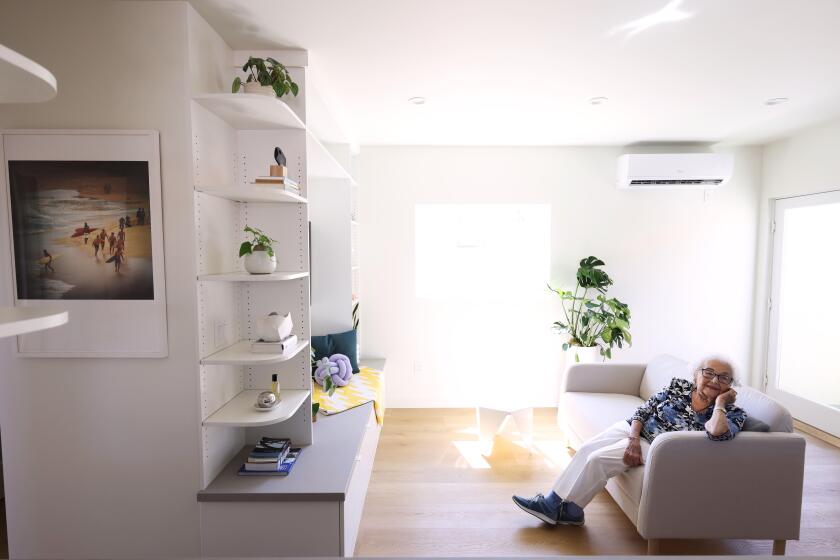Neighbors Oppose Commercial Use : Council to Hear Pleas About Historic House
Gas lamps used to light its 15 rooms, and a built-in buffet in the dining room served theater magnates at the turn of the century and Air Force heroes during World War I.
Built in 1898 for Ernest White, a Spreckles Theater executive, the White-Seifert House, a historic landmark, near Balboa Park, is today the center of a bitter dispute between its owners who want to preserve it as an office building and its neighbors who want it sold to a family who would live there.
Criminal defense attorneys Howard Frank and Joseph Milchen, who purchased the house designed by famed architects Irving Gill and Will S. Hebbard, bought it in early 1983 with the intent of converting it into an office to preserve as a historical site.
But neighbors said that the commercial use of the house on Redwood Street at 2nd Avenue would be the beginning of what they fear will be the deterioration of their quiet neighborhood.
Since the dispute began, Frank said he has been trying to find a family interested in acquiring the 3,272-square-feet mansion that sits on a 100-foot by 100-foot lot.
But there have been no offers, Frank said. “Converting it into a law firm would be the only way the property can be preserved. The only people interested in buying it would like to tear it down and put up two new homes.”
Registered by the San Diego Historic Site Board, the two-story mansion was purchased at $275,000, Frank said. He offered to sell the house for something more than $300,000. Frank and Milchen currently rent the home to two families.
Residents are passionate in their opposition to Frank’s plans.
“This is an invasion into our neighborhood,” said Alvin McGowan, 78, who lives next door to the early 20th-Century mansion. “They are just using the historical factor as a gadget to get cheap office space. We do not want criminals running through our neighborhood. There is plenty of room for them (the attorneys) downtown.”
His wife Audrey said, “It doesn’t matter whether or not they are criminal attorneys. We don’t want any attorneys or any business in this neighborhood. We would not have moved here if this wasn’t strictly residential.”
The McGowans and about 60 other neighbors, angered by a City Council decision in September to grant a conditional use permit allowing the attorneys to move into the single-family residential neighborhood, will appear April 8 at a council hearing that Mayor Roger Hedgecock promised would end the two-year dispute.
The hearing, the third before the council since last April, was ordered by Superior Court Judge Douglas R. Woodworth in January after a lawsuit was filed by the residents, organized as the Second Street Preservation Society.
The council decision to allow the law firm to occupy the White-Seifert House was reached without considering the views of property owners nearby, the residents claim, and was in violation of residential zoning regulations.
After initially turning down the request by Frank and Milchen, the San Diego planning commission in August approved the use permit, recommending that “limited commercial-office uses should be granted where necessary to preserve structures of historic and or architectural significance.”
In a letter written to the mayor and members of the City Council, Paul Robinson, attorney representing Frank and Milchen, said, “The proposed use is not without precedent in the neighborhood. Much larger law offices, of no historical significance, exist two blocks away on the corner of Thorn Street and 2nd Avenue.”
Susan Fleming, who lives one block away said she is concerned about the increased traffic and the safety of the neighborhood’s more than 40 children.
“I am very angry,” Fleming said. “It doesn’t seem fair that the City Council is changing the rules to fit the needs of this law firm.”
But Robinson said, “The neighbors are misinformed. Limited commercial use has never disturbed any neighborhood. People in the offices are there when most residents are absent. It is an added security.”
“All this seems like I am building a prison in someone’s backyard,” Robinson said. “I am not--the two attorneys get an average of two client visits a week--they see most of their clients in the courtroom or talk to them over the phone. We are meeting all the requirements, and I am building a good compliment to this neighborhood.”
More to Read
Sign up for Essential California
The most important California stories and recommendations in your inbox every morning.
You may occasionally receive promotional content from the Los Angeles Times.










